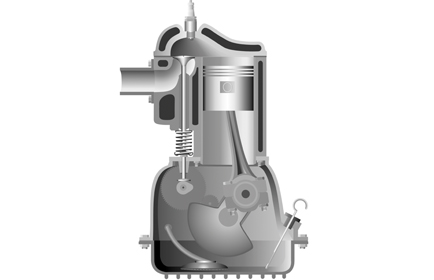Articles
Transatlantic crossing: Harry Ricardo with his American friend Harry Horning in 1932.
One of Harry Ricardo's engines transformed the tank into an effective battlefield weapon during the First World War, he devised the ‘octane number’ rating for commercial fuels, he promoted the sleeve valve aeronautical engine during the Second World War, and he redesigned the engine for the first aircraft to fly around the world without refuelling. These are just some of the achievements of Sir Harry Ralph Ricardo (1885-1974), a past president of the IMechE.
In the year Ricardo was born, Karl Benz developed his first single-cylinder petrol-engine vehicle. The evolution of this vehicle, from a primitive piece of engineering capable of a maximum of 8mph into machines capable of far above 2,500hp, was to be Ricardo’s life work. His interest in automobiles started as a schoolboy of 13 when he drove his first car, a 3.5hp Benz dog cart.
After school, he completed his education at Trinity College, Cambridge, where he was taught by Bertram Hopkinson (1874-1918), and also conducted engine research for him. Ricardo’s mix of practical expertise and acute experimental observation gave him a formidable knowledge of subjects such as engine knock and pre-ignition, about which most others knew little at that time.
In 1908 he founded the Two Stroke Engine Company. The firm exploited Ricardo’s first patented engine, the Dolphin, which was used in fishing boats and automobiles. However, the Dolphin was a relatively short-lived venture. By 1914, Ricardo was touring works in America and Europe in preparation for a senior mechanical post in the firm Rendel, Palmer and Tritton.

Side-valve engine with Ricardo's turbulent head
Ricardo later promoted new aeroengines for the Royal Naval Air Service, and was appointed engineer to the Department of Mechanical Warfare. He provided power plant designs of 150hp and 225hp for the British Mark 5 tank. His engines were manufactured in large numbers from 1917, transforming the tank into an effective battlefield weapon.
In recognition of Ricardo's work in tank engine development, the government awarded him royalties of £30,000. He used the money to establish a private centre for research into the internal combustion engine. He had already formed Engine Patents Ltd back in 1915, but in 1919 he moved its base to Shoreham, West Sussex and in 1920 named it the Ricardo Company.
The firm’s earliest contract was for fuel research for the Asiatic (Shell) Petroleum Company. From 1919 to 1921, Ricardo’s firm compiled an analysis of the quality of commercial fuels to a standard rating – eventually expressed as an ‘octane number’. This was fundamental work. Ricardo’s team of Sir David Pye FRS (1886-1960) and Sir Henry Tizard FRS (1885-1959) eventually became leading scientists in their own right. A practical consequence of Ricardo’s interest in fuel selection was the enabling of Alcock and Brown’s transatlantic flight in 1919.
In 1923, Ricardo published a book, The Internal Combustion Engine, which established him as the main authority on this subject in the inter-war years. He was elected a fellow of the Royal Society in 1929.
His practical contributions during this period included work on the world’s first diesel passenger car, the Citroën Rosalie. He also enjoyed success from 1931 with the Comet combustion chamber for high-speed diesels. His interest in aircraft engines continued, and he was associated with the competing Bristol, Napier and Rolls-Royce companies.During the Second World War, Ricardo championed the sleeve valve aeronautical engine, showing that he remained a true piston-engineer – despite his assistance to Sir Frank Whittle’s development of the jet engine, for which he designed a barometric fuel control system. The jet would eventually consume Ricardo’s own wartime high-performance type, the revolutionary Rolls-Royce Crecy engine, tested in 1944 but never flown. In 1944-45, he served as president of the IMechE.
Post-war, the Ricardo Company increasingly moved into automotive and commercial vehicle engine research, but also carried out pioneering work in other areas. For example, British Railways’ foray into diesel-mechanical Fell locomotives, developed in 1948-51, used Paxman-Ricardo prime movers.
Harry Ricardo was knighted in 1948. He retired fully in 1965 and wrote a full account of his life and times, Memories and Machines – an entertaining testimony of what it is to be an engineer. He died in 1974.
In 1970, his company became Ricardo Consulting Engineers. During the 1970s the firm pioneered the use of Stirling engines for cars on behalf of the US Department of Energy. The company has also had a notable success in Harry Ricardo’s beloved aeronautical field: in 1986, it redesigned the engine for Voyager, the first aircraft to fly around the world without refuelling.